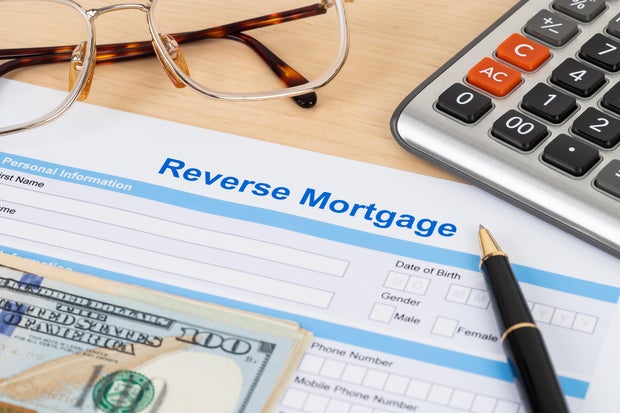Getty Images/iStockphoto
After years of high borrowing costs, many older homeowners are considering the idea of tapping into their home equity to borrow money right now. And, while there are a number of affordable ways to do this in today’s rate landscape, reverse mortgages, which let eligible homeowners 62 and older convert part of their home equity into cash, can be a smart option to consider when you’re on a fixed budget, as these loans don’t come with the same monthly loan payment obligations as you’d get with a home equity loan or home equity line of credit (HELOC).
For retirees living on limited savings and investments or seniors dealing with rising medical and household expenses, having the ability to unlock equity without taking on new monthly payments can be especially appealing now. After all, the costs of everything from healthcare to housing are rising thanks to sticky inflation, and adding another monthly payment obligation to the mix simply doesn’t make sense for many retirees.
But while reverse mortgages can provide a valuable source of supplemental income, not all products are built the same, and the type of reverse mortgage you choose can have a big impact on the flexibility, fees and long-term costs these products come with. So, if you’re thinking about a reverse mortgage soon, understanding your options is key.
Find out more about the reverse mortgage loan options available to you now.
3 reverse mortgage loan options retirees should know now
If you’re a retiree who’s considering tapping into your equity soon, it may be worth considering the following reverse mortgage loan options:
Home Equity Conversion Mortgage (HECM)
The most common type of reverse mortgage is the Home Equity Conversion Mortgage (HECM), which is a reverse mortgage loan that’s federally insured by the Federal Housing Administration (FHA). These loans account for the vast majority of reverse mortgages on the market and come with several built-in protections, including mandatory counseling sessions and non-recourse rules (meaning you or your heirs will never owe more than the home’s value).
HECMs are available through FHA-approved lenders and can be used for virtually any purpose, from covering daily living expenses to consolidating debt. Borrowers can choose from several payout options, including a lump sum, monthly payments, a line of credit or a combination of these. That flexibility makes HECMs an appealing choice for many retirees looking for a steady stream of supplemental income.
However, these loans also come with clear borrowing limits. The FHA caps how much equity you can borrow based on your age, interest rates and home value, and there are upfront mortgage insurance premiums to consider. Still, for homeowners who want a government-backed loan with consumer protections and multiple disbursement options, HECMs are typically the go-to choice.
Learn how a reverse mortgage loan could help supplement your retirement income today.
Proprietary reverse mortgages
For retirees with higher-value homes, proprietary reverse mortgages, often called jumbo reverse mortgages, can be a better fit. These private loans aren’t insured by the FHA, which means they can exceed the federal lending limits set for HECMs (currently just over $1 million in 2025). Some lenders even allow borrowers to access up to several million dollars in home equity.
Because they’re not government-insured, proprietary reverse mortgages tend to carry different terms and fewer restrictions. For example, some lenders allow borrowers as young as 55 to qualify, while others offer lower upfront costs or more flexible payout options. But with that flexibility comes risk: These loans don’t come with the same FHA protections and terms can vary widely by lender.
But if your home is worth significantly more than the FHA limit, or if you’ve already paid it off and want to access more of that equity, a proprietary reverse mortgage can be a powerful tool. Just make sure to read the fine print and compare lenders carefully to understand the costs, eligibility requirements and repayment terms.
Single-purpose reverse mortgages
The single-purpose reverse mortgage is the least common but also the most affordable option for retirees who qualify. Offered mainly by state and local governments or certain nonprofit organizations, these loans allow homeowners to borrow money for a specific, approved purpose, typically property taxes, home repairs or other essential expenses.
Because these loans are designed for limited uses and lower-income homeowners, they usually come with minimal fees and lower interest rates than HECMs or proprietary loans. However, their biggest limitation is flexibility. You can only use the funds for the purpose approved by the lender, and the loan amount tends to be smaller. For seniors struggling with necessary home improvements or tax payments, though, single-purpose reverse mortgages can be a smart option to consider.
The bottom line
With the right approach, a reverse mortgage can offer financial breathing room and peace of mind in retirement. These unique loan options offer a smart way for retirees to turn home equity into usable cash without taking on more monthly obligations, which can be especially appealing in an environment where rates are slowly easing and retirement savings are being stretched thin. Making sure you understand the differences between HECM, proprietary and single-purpose loans, though, is a crucial step to take before signing on the dotted line.




0 Comments